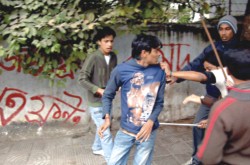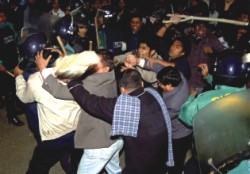Crime
The Making of Violent Minds
Anika Hossain
 |
Violent behaviour among young men is common and the result of several factors. Photos: Star file |
Every morning, when we flip through our newspapers, we see some snippets of news about murders, rapes, suicides, harassment, theft, gang violence etc. If looked at closely, one will notice that the perpetrators of these crimes are mostly youngsters, in their teens, twenties and early thirties. It's very easy to make a remark about the sad condition of our society and forget about it once we put our newspapers down, but how many of us actually believe that it can happen to us, or someone close to us? We may believe we are far removed from "people and things like that," but we are very much mistaken.
People do not become violent overnight. Violence and aggression are like seeds that are planted, and various factors contribute to help these seeds grow into something much larger and far more sinister. Anyone, regardless of their class and socio-economic background, can develop an extremely violent personality. The beginning of this process, you will be surprised to know, begins very close to home.
Psychiatrist Dr Kamaluddin Ahmed says that there are multiple factors contributing to aggression. " Research suggests that one's genetic make-up contributes to aggression," says Kamaluddin, "in most cases, if the child shows aggressive behavior, it is likely that this trait runs in his/her family," he continues. According to Dr Kamaluddin, the relationship between parents and the parent-child relationship, confusion regarding a parent's affection for their child, and parenting techniques are also contributing factors.
In Bangladesh, many parents adopt a negative parenting technique. They usually punish a behaviour, which they consider wrong, but will fail to reinforce positive ones with rewards, which contributes to a faulty character structuring. This parenting style has been practised throughout many generations. Some parents display violent, hostile behaviour, both verbally and physically, toward each other and/or the child, setting a negative example for the child, who begins to think this kind of behaviour is acceptable.
 |
Photops: Star file
|
Dr Kamaluddin opines that the education system in Bangladesh also has it's flaws which adds to the overall problem. To begin with, the education the children recieve, is all academic, and there is rarely any value based education being imparted in schools. There are other aspects of education such as extra curricular activities and sports, which are not given the importance they deserve. These activities often provide healthy outlets for the frustration a child might be feeling which may eventually turn into anger and violence. A well rounded education is therefore very important for every child.
A value based education is also very important. Schools rarely have separate lessons for socially acceptable behaviour, differentiating between right and wrong etc. They punish wrong behaviours, but rarely highlight or reward right behaviours. This character structuring is then done at home, from what children observe in their families says Kamaluddin.
Research suggests that the lack of education, unemployment and poverty are also factors which feed into this issue. When the youth of today are faced with these hardships, the anger inside them flourishes, bringing out a side in them which would not surface otherwise. In these cases, vandalism, theft and murder are used as outlets for their dissatisfaction.
Peer influence has its own role to play in contributing to violence. "One of my clients, who was caught stealing, said he likes it and does it for fun because all his friends do it too," says Kamaluddin, which goes to show the level of influence one's company may have on them. Psychosocial influences are also contributing factors says Kamaluddin. Youngsters observe violence on the streets regularly and have come to think of it as socially acceptable. The social justice system often sets an incorrect example for youngsters, by partaking in this violence.
" I know about a programme in Canada, where when youngsters are caught committing illegal activities, law enforcement officers will sit them down, maybe even buy them a burger and talk to them about what they have done wrong and the consequences of it. It is very important for authority figures to set examples," opines Kamaluddin.
The media also has a large role to play when it comes to setting negative examples for our youth. Most television programmes will glorify violence and portray it as a solution to conquering all evil. This often sends a message that this is also true in reality, leading to a display of more destructive behaviour in the name of heroism. The media also often shows that the use of alcohol and other substances boosts courage and energy, which in reality is not the case. Correctional measures can be taken, by televising programmes which show that violence is irrational and unnecessary and outline the consequences of substance abuse says Kamaluddin.
Substance abuse is also a factor, which should not be underestimated. Nowadays, drugs and alcohol are available in every corner and alley. According to Dr Kamaluddin there a two types of drugs, which can bring out one's violent side. Opiates, which are both physically and psychologically addictive, the most common one available being heroine. When a person is addicted to heroine, the lack of access or availability can make the addict extremely vicious and dangerous. Amphetamines are another category of drugs, which are taken because the user feels energised and able to take on anything when under the influence. Users can stay awake for long hours without needing rest, they may also lose large amounts of weight very quickly if they use it for a long period of time. Since the body builds tolerance to amphetamines very quickly if they are used regularly, the user usually increases the dose they take very rapidly. These are stimulants, which work like alcohol, nicotine and cocaine on the brain.
Amphetamine, will rid you of all inhibitions and make you commit crimes when under its influence says Dr Kamaluddin. The drugs most polularly used in Bangladesh are yaba, smack and speed. The addiction is so strong, that youngsters are compelled to steal, rob and often commit brutal crimes to obtain money to purchase these drugs, says Kamaluddin.
The main reason youngsters start using drugs is because there is very little for them to do outside of school and work. There are limited recreational activities and facilities available to be them and as a result, they use their leisure time to experiment with different substances. As the saying goes, the idle mind is the devil's workshop, and so it is.
There are many solutions to these problems. The difficulty lies in implementing them. Developing a value based pre-school learning system, which teaches impulse control and differentiates between right and wrong, reducing illiteracy by establishing more government schools, practising proper parenting skills and improving family relationships through counseling, having programmes available to teach parents these skills are effective ways to prevent violent and aggressive behaviour.
Having a law enforcement system which will deal with young criminals differently, by sending them to a correctional facility rather than prison, televising educational programmes and either banning violence or presenting it for what it is, an irrational unnecessary act through the media, taking punitive measures against drug dealers, and educating children about the harmful effects of drugs are also ways in which violence in our current generation can be prevented .
The changes will not happen overnight, in a month or even a year. Every responsible member of the society has to contribute to make these changes happen. The government must take measures to reduce political violence and make appropriate laws obliging the law enforcement officers and the education system to change. The important point to remember is that change is possible and at this point, we do not have an option but to work toward it.
Copyright
(R) thedailystar.net 2010 |
| |
